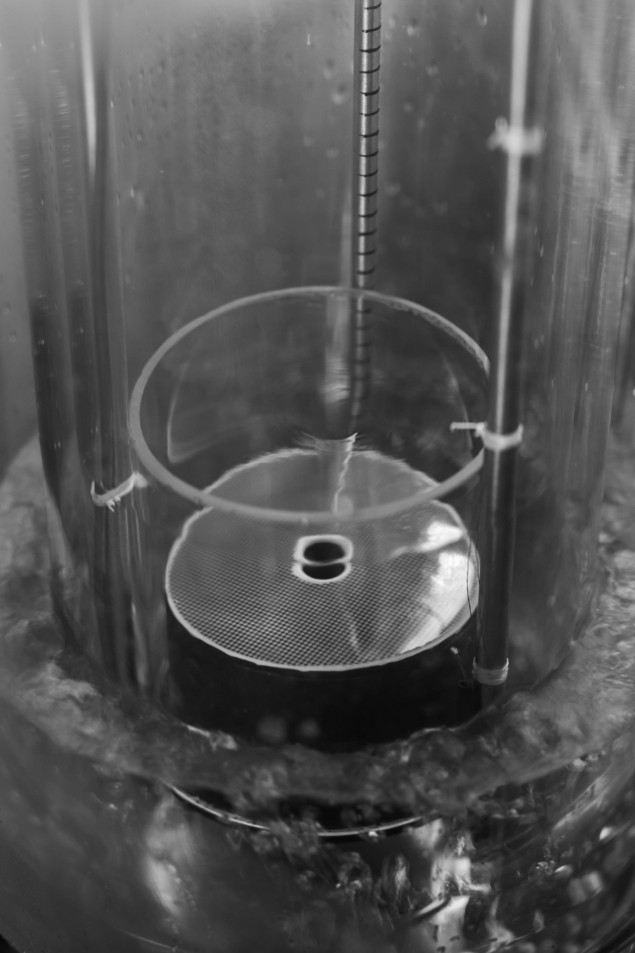
A novel experimental platform known as a giant quantum vortex mimics certain behaviours of black holes, giving scientists an opportunity to observe the physics of these astrophysical structures up close. The vortex appears in superfluid helium cooled to near-absolute zero temperatures, and according to the team that made it, studies of its dynamics could offer hints as to how cosmological black holes produce their characteristic rotating curved space–times.
Black holes exert huge gravitational forces on their surroundings, curving the fabric of space–time to an extent that is unprecedented among other structures we observe in the universe. These forces are so big that they drag the fabric of space–time around them as the black hole rotates, creating uniquely turbulent environments.
Such dramatic effects obviously cannot be studied in the laboratory, so researchers are exploring ways of making structures that mimic them. For example, gravity and fluid dynamics behave somewhat similarly if the viscosity of the fluid is extremely low, as is the case for liquid helium (a superfluid, meaning it flows with little or no friction) and clouds of cold atoms.
Vortex flows created in a kitchen blender
At near zero temperatures (less than –271 °C), liquid helium contains tiny swirling structures known as quantum vortices. Normally, these vortices stay apart, explains Patrik Svancara, a physicist at the University of Nottingham, UK. In the latest study, however, Svancara, co-team leader Silke Weinfurtner, and colleagues at King’s College London and Newcastle University managed to confine tens of thousands of these quanta in a compact object that resembles a tornado.
“The central part of our set-up is a spinning propeller that establishes a continuous circulating loop of superfluid helium, stabilizing the vortex formed above it,” Weinfurtner and Svancara explain. This set-up, they add, was inspired by researchers in Japan, who likewise produced giant vortex flows in a device that resembles a kitchen blender, rather than by placing the entire experimental apparatus on a rotating platform.

From ordinary fluids to superfluids
The researchers began their experiments with rotating fluids back in 2017, when they observed black hole-mimicking wave dynamics in a specially designed “bathtub” containing almost 2000 litres of water. “This was a breakthrough moment for understanding some of the bizarre phenomena that are often challenging, if not impossible, to study otherwise,” says Weinfurtner, a physicist at Nottingham’s Black Hole Laboratory, where the experiment was conceived and developed. “Now, with our more sophisticated experiment, we have taken this research to the next level, which could eventually lead us to predict how quantum fields behave in curved space–times around astrophysical black holes.”
Transitioning from classical fluids like water to quantum ones like superfluid helium was essential, Weinfurtner explains, because the superfluid’s viscosity is much smaller. Superfluids also display unique quantum-mechanical properties like the quantization of vortex strength, meaning that any vortex in superfluid helium must be composed of elementary quanta called quantum vortices. “Setting up large vortices like ours is challenging since individual quanta tend to move apart from each other, as Patrik mentioned,” Weinfurtner tells Physics World, “but we were able to stabilize vortex flows that accommodate tens of thousands of quanta in a compact region, [which] is a record-breaking value in the realm of quantum fluids.”
The new structure will help researchers simulate quantum field dynamics within complex rotating curved space-times, like black holes, and offer an alternative to the two-dimensional ultracold systems conventionally used in such studies until now, she adds.

Giant vortex clusters appear in 2D superfluids
“Leveraging advanced flow control techniques and high-resolution detection methods to detect the wave dynamics on the superfluid’s surface has allowed us to extract macroscopic flow structures and visualize intricate wave-vortex interactions,” she says. “These observations have revealed the presence of microscopic bound states and phenomena of black-hole-like ringing on the free surface of a giant quantum vortex, which we are currently investigating further.”
The researchers now plan to enhance the accuracy of their detection method and explore regimes in which the quantization of vortex strength becomes important. “This feature could influence the way black holes interact with their surroundings, potentially teaching us about the physics of black holes,” Svancara says.
The present work is detailed in Nature.



